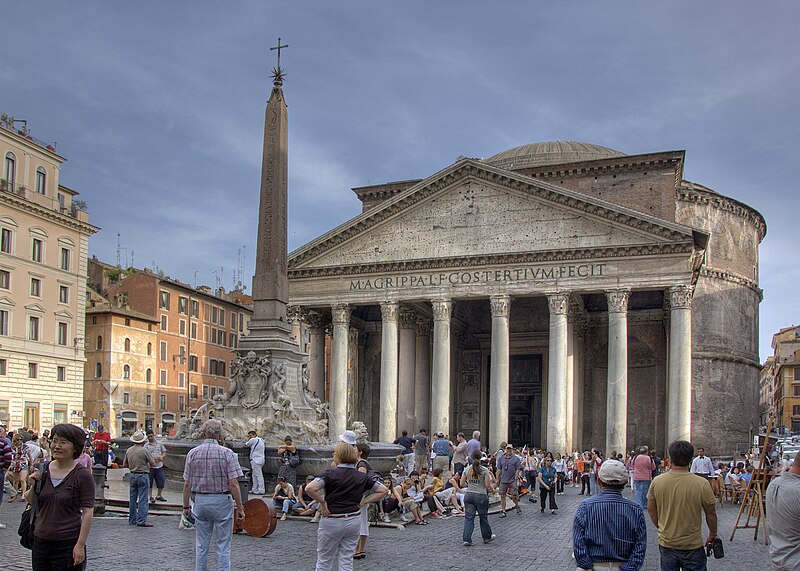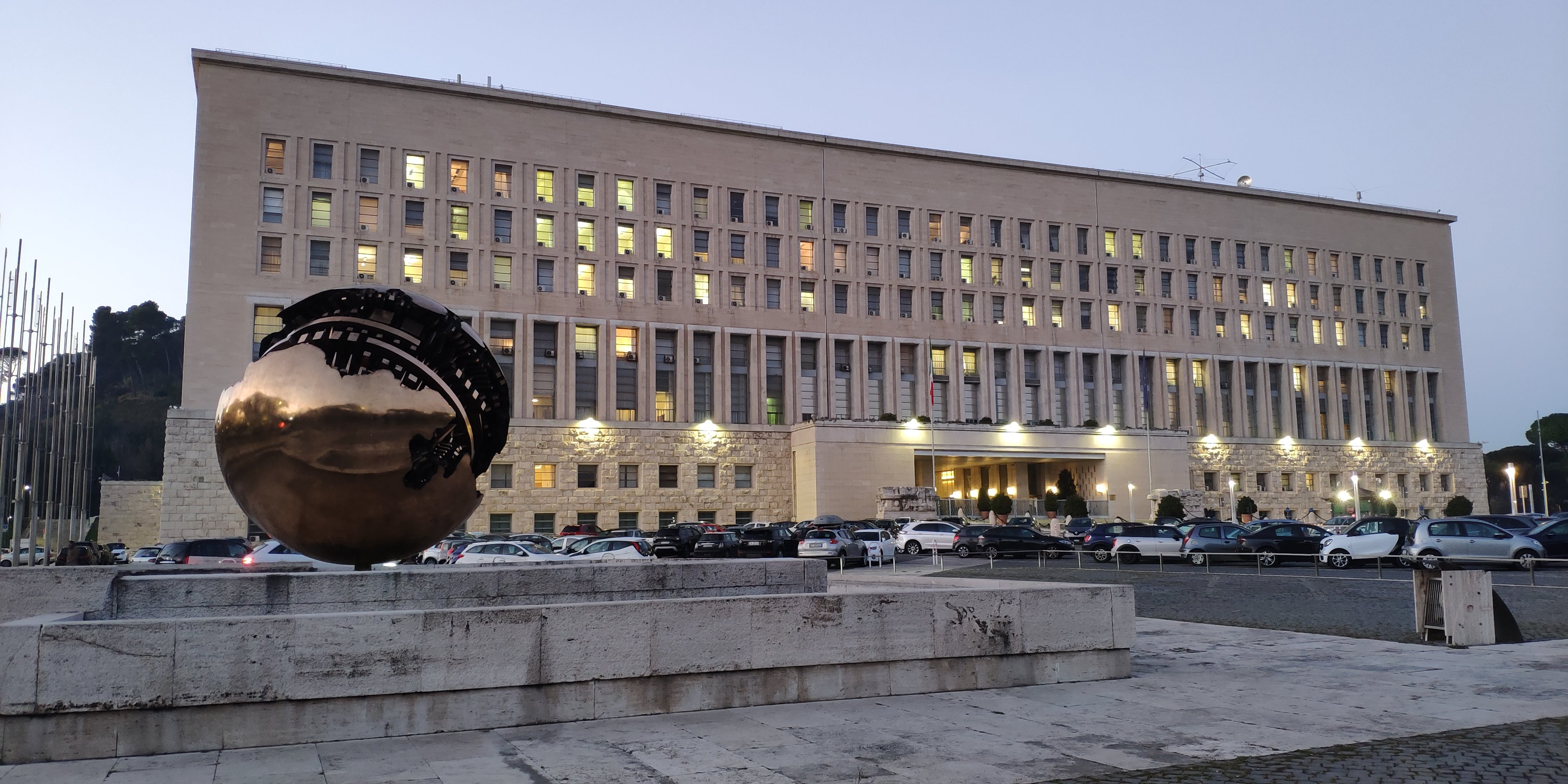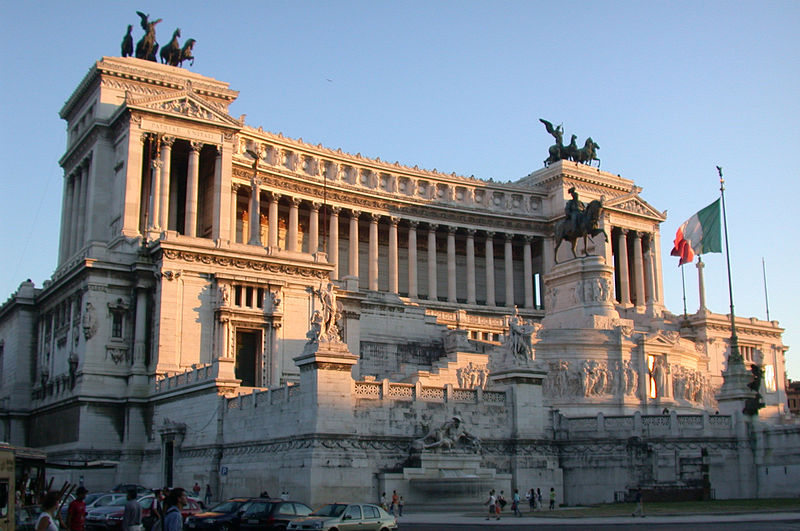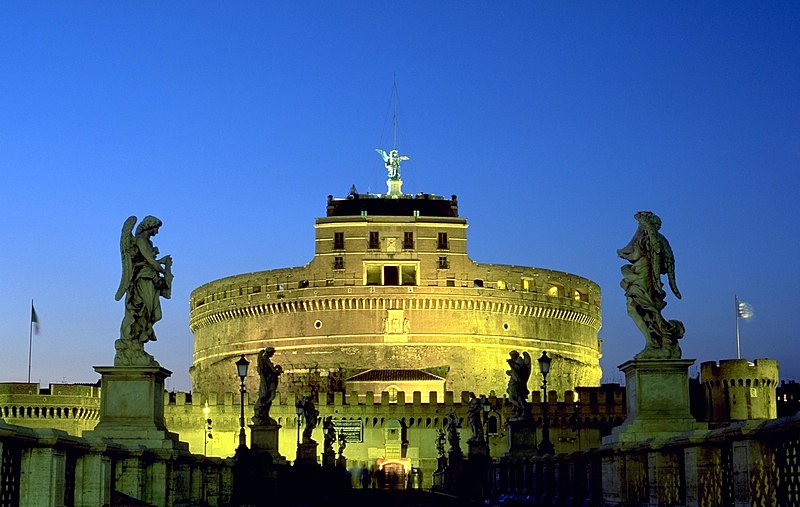 Rome (English pronunciation: /ˈroʊm/; Italian: Roma pronounced [ˈroːma] ( listen); Latin: Rōma) is the capital of Italy and the country's largest and most populated city and comune, with over 2.7 million residents in 1,285.3 km2 (496.3 sq mi). The city is located in the central-western portion of the Italian Peninsula, on the Tiber River within the Lazio region of Italy.
Rome (English pronunciation: /ˈroʊm/; Italian: Roma pronounced [ˈroːma] ( listen); Latin: Rōma) is the capital of Italy and the country's largest and most populated city and comune, with over 2.7 million residents in 1,285.3 km2 (496.3 sq mi). The city is located in the central-western portion of the Italian Peninsula, on the Tiber River within the Lazio region of Italy.
Rome's history spans two and a half thousand years. It was the capital city of the Roman Kingdom, the Roman Republic and the Roman Empire, which was the dominant power in Western Europe and the lands bordering the Mediterranean for over seven hundred years from the 1st century BC until the 7th century AD. Since the 1st century AD Rome has been the seat of the Papacy and, after the end of Byzantine domination, in the 8th century it became the capital of the Papal States, which lasted until 1870. In 1871 Rome became the capital of the Kingdom of Italy, and in 1946 that of the Italian Republic.

After the Middle Ages, Rome was ruled by popes such as Alexander VI and Leo X, who transformed the city into one of the major centers of the Italian Renaissance, along with Florence. The current version of St Peter's Basilica was built and the Sistine Chapel was painted by Michelangelo. Famous artists and architects, such as Bramante, Bernini and Raphael resided for some time in Rome, contributing to its Renaissance and Baroque architecture.

Rome has been ranked by GaWC in 2010 as a beta+ world city, as well as the 28th most important global city.[4] In 2007, Rome was the 11th-most-visited city in the world, 3rd most visited in the European Union, and the most popular tourist attraction in Italy. The city is one of Europe's and the world's most successful city "brands", both in terms of reputation and assets. Its historic centre is listed by UNESCO as a World Heritage Site. Monuments and museums such as the Vatican Museums and the Colosseum are amongst the world's 50 most visited tourist destinations (the Vatican Museums receiving 4.2 million tourists and the Colosseum receiving 4 million tourists every year). Rome hosted the 1960 Summer Olympics and is currently bidding to host the 2020 Summer Olympics
History
There is archaeological evidence of human occupation of the Rome area from at least 14,000 years, but the dense layer of much younger debris obscures Palaeolithic and Neolithic sites.[14] Evidence of stone tools, pottery and stone weapons attest to at least 10,000 years of human presence. The power of the well known tale of Rome's legendary foundation tends also to deflect attention from its actual, and much more ancient, origins.
Monarchy, republic, empire
Main articles: Ancient Rome, Roman Kingdom, Roman Republic, and Roman Empire
Capitoline Wolf suckles the infant twins Romulus and Remus.
Rome's early history is shrouded in legend. According to Roman tradition, the city was founded by Romulus on 21 April 753 BC. The legendary origin of the city tells that Romulus and Remus decided to build a city. After an argument, Romulus killed his brother Remus. Archaeological evidence supports the view that Rome grew from pastoral settlements on the Palatine Hill built in the area of the future Roman Forum. While some archaeologists argue that Rome was indeed founded in the middle of the 8th century BC, the date is subject to controversy. The original settlement developed into the capital of the Roman Kingdom (ruled by a succession of seven kings, according to tradition), and then the Roman Republic (from 510 BC, governed by the Senate), and finally the Roman Empire (from 27 BC, ruled by an Emperor). This success depended on military conquest, commercial predominance, as well as selective assimilation of neighbouring civilisations, most notably the Etruscans and Greeks. From its foundation Rome, although losing occasional battles, had been undefeated in war until 386 BC, when it was briefly occupied by the Gauls.[19] According to the legend, the Gauls offered to deliver Rome back to its people for a thousand pounds of gold, but the Romans refused, preferring to take back their city by force of arms rather than ever admitting defeat, after which the Romans recovered the city in the same year.
Map depicting late ancient Rome.
The Republic was wealthy, powerful and stable before it became an empire. According to tradition, Rome became a republic in 509 BC. However, it took a few centuries for Rome to become the great city of popular imagination, and it only became a great empire after the rule of Augustus (Octavian). By the 3rd century BC, Rome had become the pre-eminent city of the Italian peninsula, having conquered and defeated the Sabines, the Etruscans, the Samnites and most of the Greek colonies in Sicily, Campania and Southern Italy in general. During the Punic Wars between Rome and the great Mediterranean empire of Carthage, Rome's stature increased further as it became the capital of an overseas empire for the first time. Beginning in the 2nd century BC, Rome went through a significant population expansion as Italian farmers, driven from their ancestral farmlands by the advent of massive, slave-operated farms called latifundia, flocked to the city in great numbers. The victory over Carthage in the First Punic War brought the first two provinces outside the Italian peninsula, Sicily and Corsica et Sardinia. Parts of Spain (Hispania) followed, and in the beginning of the 2nd century the Romans got involved in the affairs of the Greek world. By then all Hellenistic kingdoms and the Greek city-states were in decline, exhausted from endless civil wars and relying on mercenary troops. This saw the fall of Greece after the Battle of Corinth (146 BC) and the establishment of Roman control over Greece.

The Roman Empire at its greatest extent controlled approximately 6.5 million km2 of land surface.
The Roman Empire had begun more formally when Emperor Augustus (63 BC–AD 14; known as Octavian before his throne accession) founded the Principate in 27 BC.This was a monarchy system which was headed by an emperor holding power for life, rather than making himself dictator like Julius Caesar had done, which had resulted in his assassination on 15 March, 44 BC. 

At home, Emperor Augustus started off a great programme of social, political and economic reform and grand-scale reconstruction of the city of Rome. The city became dotted with impressive and magnificent new buildings, palaces, fora and basilicae. Augustus became a great and enlightened patron of the arts, and his court was attended by such poets as Virgil, Horace and Propertius. His rule also established the Pax Romana, a long period of relative peace which lasted approximately 200 years. Following his rule were emperors such as Caligula, Nero, Trajan, and Hadrian, to name a few. Roman emperor Nero was well known for his extravagance, cruelty, tyranny, and the myth that he was the emperor who "fiddled while Rome burned" during the night of 18 to 19 July 64 AD. The Antonine Plague of 165–180 is believed to have killed as much as one-third of the population.
Roman dominance expanded over most of Western Europe and the shores of the Mediterranean, though its influence through client states and the sheer power of its presence was wider than its formal borders. Its population surpassed one million inhabitants. For almost a thousand years, Rome was the most politically important, richest, and largest city in the Western world. After the Empire started to decline and was split, it lost its capital status to Milan and then to Ravenna, and was surpassed in prestige by the capital of the Eastern Roman Empire, Constantinople, whose Greek inhabitants continued through the centuries to call themselves Roman.
Early modern
The latter half of the 15th century saw the seat of the Italian Renaissance move to Rome from Florence. The Papacy wanted to equal and surpass the grandeur of other Italian cities and to this end created ever more extravagant churches, bridges, town squares and public spaces, including a new Saint Peter's Basilica, the Sistine Chapel, Ponte Sisto (the first bridge to be built across the Tiber since antiquity), and Piazza Navona. The Popes were also patrons of the arts engaging such artists as Michelangelo, Perugino, Raphael, Ghirlandaio, Luca Signorelli, Botticelli, and Cosimo Rosselli.

The Tempietto (San Pietro in Montorio), which is an excellent example of Italian Renaissance architecture
The period was also infamous for papal corruption, with many Popes fathering children, and engaging in nepotism and simony. The corruption of the Popes and the extravagance of their building projects led, in part, to the Reformation and, in turn, the Counter-Reformation. Popes, such as Alexander VI, were well known for their decadence, wild parties, extravagance and immoral lives.However, under these extravagant and rich popes, Rome was transformed into a centre of art, poetry, music, literature, education and culture. Rome became able to compete with other major European cities of the time in terms of wealth, grandeur, the arts, learning and architecture.

Michelangelo's ceiling in the Sistine Chapel.
Rome in 1642
The Renaissance period changed Rome's face dramatically, with works like the Pietà by Michelangelo and the frescoes of the Borgia Apartment, all made during Innocent's reign. Rome reached the highest point of splendour under Pope Julius II (1503–1513) and his successors Leo X and Clement VII, both members of the Medici family. In this twenty-year period Rome became one of the greatest centres of art in the world. The old St. Peter's Basilica built by Emperor Constantine the Great (which by then was in a terrible state) was demolished and a new one begun. The city hosted artists like Ghirlandaio, Perugino, Botticelli and 

Bramante, who built the temple of San Pietro in Montorio and planned a great project to renovate the Vatican. Raphael, who in Rome became one the most famous painters of Italy creating frescos in the Cappella Niccolina, the Villa Farnesina, the Raphael's Rooms, plus many other famous paintings. Michelangelo started the decoration of the ceiling of the Sistine Chapel and executed the famous statue of the Moses for the tomb of Julius. Rome lost in part its religious character, becoming increasingly a true Renaissance city, with a great number of popular feasts, horse races, parties, intrigues and licentious episodes. Its economy was rich, with the presence of several Tuscan bankers, including Agostino Chigi, who was a friend of Raphael and a patron of arts. Before his early death, Raphael also promoted for the first time the preservation of the ancient ruins. The fight between France and Spain in Europe caused the first plunder of the City in more than one thousand years. In 1527 the Landsknechts of Emperor Charles V sacked the city, putting to an abrupt end the golden age of the Renaissance in Rome.

Beginning with the Council of Trent in 1545, the Church began the Counter-Reformation as an answer to the Reformation, a large-scale questioning of the Church's authority on spiritual matters and governmental affairs. (This loss of confidence then lead to major shifts of power away from the Church.) Under the popes from Pius IV to Sixtus V, Rome became the center of the reformed Catholicism and saw the installment of new monuments which celebrated the papacy's restored greatness. The popes and cardinals of the 17th and early 18th centuries continued the movement by having city's landscape enriched with baroque buildings. During the Age of Enlightenment, new ideas reached also the Eternal City, where the papacy supported archeological studies and improved the people's welfare. But not everything went well for the Church during the Counter-Reformation.
There were setbacks in the attempts to restrain the anti-Church policies of European powers of the time. The most notable setback perhaps being in 1773 when Pope Clement XIV was forced by secular powers to have the Jesuit order suppressed.
Cuisine
Rome's cuisine has evolved through centuries and periods of social, cultural, and political changes. Rome became a major gastronomical centre during Ancient Rome. Ancient Roman Cuisine was highly influenced by Ancient Greek culture, and after, the empire's enormous expansion exposed Romans to many new, provincial culinary habits and cooking techniques. In the beginning, the differences between social classes were not very great, but disparities developed with the empire's growth. Later, during the Renaissance, Rome became well known as a centre of high-cuisine, since some of the best chefs of the time, worked for the popes. An example of this could be Bartolomeo Scappi, who was a chef, working for Pius IV in the Vatican kitchen, and he acquired fame in 1570 when his cookbook Opera dell'arte del cucinare was published. In the book he lists approximately 1000 recipes of the Renaissance cuisine and describes cooking techniques and tools, giving the first known picture of a fork.[90] Today, the city is home to numerous formidable and traditional Italian dishes. A Jewish influence can be seen, as Jews have lived in Rome since the 1st century BCE. Vegetables, especially globe artichokes, are common.[91] Examples of these include "Saltimbocca alla Romana" – a veal cutlet, Roman-style; topped with raw ham and sage and simmered with white wine and butter; "Carciofi alla giudia" – artichokes fried in olive oil, typical of Roman Jewish cooking; "Carciofi alla romana" – artichokes Roman-style; outer leaves removed, stuffed with mint, garlic, breadcrumbs and braised; "Spaghetti alla carbonara" – spaghetti with bacon, eggs and pecorino, and "Gnocchi di semolino alla romana" – semolina dumpling, Roman-style, to name but a few.

Sports

Football (soccer) is the most popular sport in Rome, as in the rest of the country. The city hosted the final games of the 1934 and 1990 FIFA World Cup. The latter took place in the Olympic Stadium, which is also the home stadium for local Serie A clubs A.S. Roma and S.S. Lazio, whose rivalry has become a staple of Roman sports culture. Footballers who play for these teams and are also born in the city tend to become especially popular, as has been the case with players such as Francesco Totti and Daniele De Rossi (both for A.S. Roma). Atletico Roma is a minor team that plays in First Division; its home stadium is Stadio Flaminio.
Rome hosted the 1960 Summer Olympics, with great success, using many ancient sites such as the Villa 

Borghese and the Thermae of Caracalla as venues. For the Olympic Games many new structures were created, notably the new large Olympic Stadium (which was also enlarged and renewed to host qualification and the final match of the 1990 FIFA World Cup), the Villaggio Olimpico (Olympic Village, created to host the athletes and redeveloped after the games as a residential district), etc. Rome is currently bidding to host the 2020 Summer Olympics.[10][95]
Rugby union is gaining wider acceptance. The Stadio Flaminio is the home stadium for the Italy national rugby union team, which has been playing in the Six Nations Championship since 2000, albeit with less than satisfactory performances, as they have never won the championship. Rome is home to local rugby teams, such as Unione Rugby Capitolina, Rugby Roma, and S.S. Lazio.

Every May, Rome hosts the ATP Masters Series tennis tournament on the clay courts of the Foro Italico. Cycling was popular in the post-World War II period, although its popularity has faded. Rome has hosted the final portion of the Giro d'Italia twice, in 1989 and 2000. Rome is also home to other sports teams, including basketball (Virtus Roma), volleyball (M. Roma Volley), handball or waterpolo.
No comments:
Post a Comment